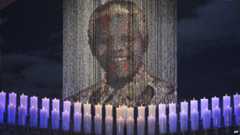

President Zuma was at the unveiling of a new statue of Nelson Mandela
A statue of Nelson Mandela, South Africa's first black president, has been unveiled in the capital, Pretoria, a day after he was buried.
The nine-metre (30ft) bronze statue has been erected at the Union Buildings, the government headquarters.
The statue, with Mr Mandela's hands reaching outward, was intended to show that he had embraced the whole nation, President Jacob Zuma said.
Mr Mandela was given a state funeral at his ancestral home on Sunday.
End QuoteNelson Mandela is now resting under the peaceful Qunu skies. It was a funeral the like of which South Africa has never seen for the nation's beloved Madiba”
 Pumza FihlaniBBC News, Qunu
Pumza FihlaniBBC News, QunuAfrican National Congress (ANC) members, veterans of the fight against apartheid and foreign dignitaries - including several African presidents and the Prince of Wales - attended the funeral ceremony in the village of Qunu in South Africa's Eastern Cape province.
It followed a 10-day period of mourning and celebrating Mr Mandela's life after his death at the age of 95.
The national flag was raised on Monday from its half-mast position, and was flying as normal.
'Battle of Blood River'The statue was unveiled on South Africa's Day of Reconciliation, a public holiday which marks the end of racial conflict in South Africa.

1918 Born in the Eastern Cape
1943 Joined African National Congress
1956Charged with high treason, but charges dropped after a four-year trial
1962Arrested, convicted of incitement and leaving country without a passport, sentenced to five years in prison
1964 Charged with sabotage, sentenced to life
1990Freed from prison
1993Wins Nobel Peace Prize
1994Elected first black president
1999Steps down as leader
2013Dies aged 95
"Former President Mandela is associated with the promotion of reconciliation which is why the day was chosen for the unveiling," said the government.
During white minority rule, 16 December was called the Day of Covenant to honour the victory of Afrikaners over a Zulu army in an 1838 clash known as the Battle of Blood River.
More than a century later, on 16 December 1961, Mr Mandela launched an armed group, Umkhonto we Sizwe (Spear of the Nation), to fight South Africa's white minority rule.
It led to his arrest and imprisonment for 27 years.
After he became president in 1994 at the end of minority rule, he used the day to urge South Africans to set aside their differences and to unite.
During his address at the funeral on Sunday, Mr Zuma pledged to build on Mr Mandela's legacy.
"As your journey ends today, ours must continue in earnest... South Africa will continue to rise because we dare not fail you," he said.
Mr Mandela's body lay in state at the Union Buildings for three days last week, at least 100,000 people filed past his open casket to pay their last respects.
 Nelson Mandela's smiling portrait welcomed the guests inside the giant marquee in Qunu
Nelson Mandela's smiling portrait welcomed the guests inside the giant marquee in Qunu Nelson Mandela always said he wanted to be buried in his childhood home
Nelson Mandela always said he wanted to be buried in his childhood home President Zuma sat between Mr Mandela's widow Graca Machel and his ex-wife Winnie Madikizela-Mandela
President Zuma sat between Mr Mandela's widow Graca Machel and his ex-wife Winnie Madikizela-Mandela Mandela buried at ancestral home
Mandela buried at ancestral homeSouth Africa's first black president Nelson Mandela is buried at his ancestral home after a state funeral.
 Road to Qunu
Road to QunuFollow Fergal Keane's journey in tweets and video to the village where Nelson Mandela was buried.
The BBC is not responsible for the content of external Internet sites
 Fighting spreads in South Sudan
Fighting spreads in South SudanFighting is spreading in parts of South Sudan, leaving hundreds of people dead, after a reported coup attempt at the weekend.
 Bygone Bohemia Watch
Bygone Bohemia WatchGentrification threatens New York's Chelsea Hotel
 Inside job
Inside jobHow one of Italy's oldest libraries was plundered - by the librarian
 Painful memories
Painful memoriesBangladesh 1971 - revisiting the scene of my grandfather's murder
 Money, money, money
Money, money, moneyDo Chinese people really measure success by what they own?
 The good life
The good lifeFancy living in one of the world’s healthiest cities? BBC Travel takes a look at who comes out on top
 Click Watch
Click WatchHow new technology could help keep cyclists safe by alerting bus and lorry drivers to their presence

BBC © 2013The BBC is not responsible for the content of external sites. Read more.
This page is best viewed in an up-to-date web browser with style sheets (CSS) enabled. While you will be able to view the content of this page in your current browser, you will not be able to get the full visual experience. Please consider upgrading your browser software or enabling style sheets (CSS) if you are able to do so.